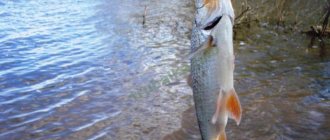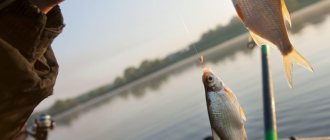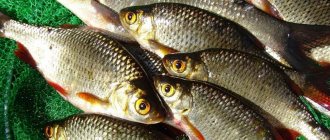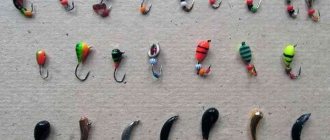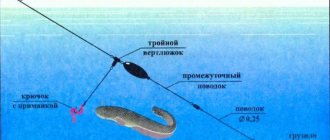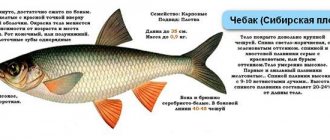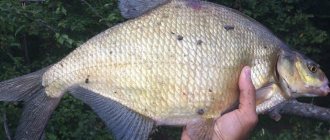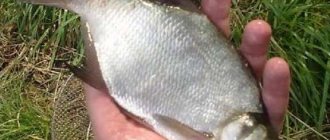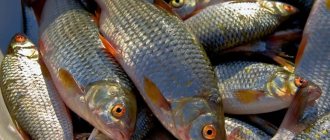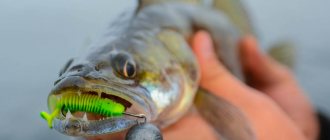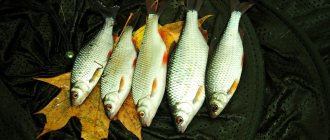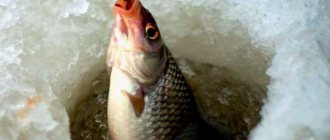Fishing rod rig for roach fishing in July and August
A float rod is the simplest and most accessible fishing tackle for roach. They catch this fish both in the current and in still water, which imposes its own requirements on the configuration and characteristics of the gear used in certain conditions.
On the current behind the roach
When fishing in the current, use Bolognese 5-7 meter rods with small inertia-free reels on which equipment is wound, consisting of:
- 20-30 meter supply of monofilament with a cross-section of 0.16-0.18 mm;
- A float with a spindle-shaped or barrel-shaped body, a long antenna and a load capacity of at least 4 g;
- Loads consisting of a sliding sinker (about 80% of the load), olives and graze (20% of the load);
- A leash 20-25 cm long made of monofilament with a cross-section of 0.12-014 mm with a NoNo10-12 hook. Read also: Tying the leash correctly - this is important!
In still water
For fishing in still water, fly and Bolognese rods 5-6 meters long are used with equipment consisting of:
- Main line with a cross section of 0.12-0.14 mm;
- Spindle-shaped float with a weight of 2-2.5 g;
- A load consisting of the main load and a sub-grass located from it at a distance of 20-25 cm.
- Leash 15-20 cm long made of monofilament with a cross-section of 0.1 mm with a NoNo 12-14 hook
In addition, when fishing in reservoirs without a current, match gear is used to cast over a distance of over 20-30 meters. It consists of:
- a special match rod 3.6-4.2 m long;
- match reel with shallow spool size 3000
- Equipment - sinking monofilament line with a cross-section of 0.14-0.16 mm, a large float with a load capacity of 6-8 to 16-18 g, a long (50-80 cm) leash made of monofilament 0.1-0.12 mm thick with a hook NoNo12-14.
Looking for roach in August
In August, roach's feeding preferences may include a wide variety of foods. Fish responds well to almost all baits, both plant and animal. Although roach is a common inhabitant of our reservoirs, it tries to stick to its favorite places. In August they are grassy backwaters and bays near the pits.
On hot August days, the fish rush to the depths, but in cool weather, they can often be found near the shore.
In any case, in August roach is found at any depth, but trophy individuals of this species prefer to lead a solitary lifestyle at great depths. But the fisherman should know that if not a single bite is observed within 30 minutes of active feeding, then it is better to change the place. In August, roaches are especially active on cloudy days, from morning until evening. The fish does not like sudden weather changes that affect its activity.
What do roaches bite on in June and August?
Roaches bite in July and August, both on plant baits and bait. Among plant baits, roach prefers the following:
- Boiled pearl barley;
- Semolina chatter;
- Bread crumb;
- Dough;
- Pea porridge (“Mastyrka”);
- Filamentous green algae (mulberry);
- Boiled pearl barley;
- Pea grains;
The main baits for catching roach in July and August are:
- Bloodworm;
- Maggot;
- Crawling out;
- Caddisfly larva (shitik);
- Various types of grasshoppers;
- Horse leech.
Nozzles used
In August, roach readily responds to any type of bait offered to it. At the beginning of the month, fish prefer to peck on plant baits:
- boiled pearl barley;
- talker;
- whole oat flakes;
- steamed wheat grains;
- corn.
Boiled pearl barley and chatterbox have a special attraction for roach, because when immersed in water they form a small cloud of turbidity around themselves, which additionally attracts the fish and awakens its appetite. Oatmeal flakes scalded with boiling water are also an excellent bait because, due to their shape, they slowly float in the water column, provoking roaches to bite. Steamed wheat grains and corn hold securely on the hook and are more often used when fishing in the current. At the end of August, the water temperature drops, and the roach begins to respond better to bait of animal origin:
- bloodworm;
- maggot;
- bark beetle;
- caddisfly.
The bloodworm should be placed at the very edge of the head so that it remains mobile longer and attracts the attention of the fish.
Bloodworms with maggots are universal baits that work well both in lakes and reservoirs, and on the river. Bark beetles and caddis flies are best used for river fishing.
Fishing for roach in August can be very exciting and gives the fisherman a lot of positive emotions. With the right choice of tackle, bait and bait, an angler can always count on a good bite.
Bait for roach in July and August
At this time, the following components are added to the bait produced independently for catching roach:
- The base is breadcrumbs, ground shortbread, sunflower cake, milk powder, semolina. All components of the base are mixed with the boiled components of the feed in dry form. In the total mass of the mixture, the base should be approximately 75-80%.
- Feed part (25-20% by weight of the entire mixture) – boiled pearl barley, millet, peas;
- Flavorings – honey, coriander, dill, molasses.
Ballast (weighting agent) – red clay or coastal soil.
Features of catching crucian carp in August using a float rod
Peculiarities of behavior and fishing for crucian carp in August:
The fish are biting like crazy! You can even put bait on it. The poacher spilled the beans.
35 kg of fish per pheromone bait. Fishing report!
- Crucian carp spawn for a long time, from May until the end of the first month of summer. In August, after a painful transition, the bite noticeably improves;
- When fishing, you will have to deal with reservoirs with blooming water, a lot of grass, and a littered bottom;
- Fishing for crucian carp usually occurs where carp, carp, and bream are found;
- Crucian carp takes from the bottom;
- In August they are caught using both plant and animal baits. But crucian carp gives preference to plant baits;
- Individuals over a kilogram are taken more confidently on large baits;
- Crucian carp is picky and its taste changes throughout the day. You need to have at least three attachments in stock with different smells and tastes;
- The bite throughout the day is very uneven. In most cases, the best bite is guaranteed at sunset and in the pre-dawn hours. A decent bite at night is not uncommon.
Useful tips
- In reservoirs near hayfields and pastures, water meadows, when grasshoppers appear, they catch very productively with this bait by removing the main part of the weight and installing a light feather float. With this fishing method, the bait slowly sinks, attracting the attention of the roach, which takes it almost “on the fly.”
- When fishing in reservoirs with stagnant water, bait weighted with clay or soil is rolled into small balls or thrown in bulk
- To weigh down the bait, you should not use sand - a bait ball with such ballast will begin to fall apart in the upper layers of the water and attract bleak and other small fish.
- When fishing in a current, the bait must be rolled into balls with a diameter of 5-8 cm. The density of the ball depends on the strength of the current - the stronger it is, the denser the bait ball should be.
- When catching roach with bloodworms and maggots, in order not to damage the bait too much and to maintain its appearance attractive to fish, you should use small hooks NoNo12-14 made of thin strong wire.
- When fishing in mid-late August, small bloodworms and maggots are added to the bait mixture.
Features of the bait mixture
Bait is the most important component on which the final result of fishing largely depends. The bait mixture for roach should be very light and contain only small fractions. Most fishermen purchase ready-made bait, but professional fishermen prefer to independently select the composition of the bait mixture. Having learned to combine the components correctly, the angler will be able to prepare a mixture that ideally meets certain fishing conditions. The following components are usually used to prepare roach bait:
- breadcrumbs;
- corn flour;
- finely ground wheat bran;
- oatmeal (ground oatmeal);
- powdered milk;
- sunflower, hemp and coconut cake.
Particular attention should be paid to the process of moistening the bait. The degree of moisture should be such that the bait ball breaks into the water upon splashdown - this will create a vertical column of food particles in the water and quickly collect roach at the fishing point. To prevent the fish from leaving the fishing spot, the angler must regularly throw small balls of bait into the water, maintaining the resulting column of turbidity.
Adding animal components to bait increases the number of bites many times over.
The principle of feeding roach on the current is radically different from what is used in standing water. It is necessary to add heavy soil to the mixture for river fishing, which will prevent the food from being quickly washed away by the water flow. For river fishing you will need dense balls of bait that quickly reach the bottom.
The bait will work much more efficiently if you add to its composition those components that are used as bait. Small fish are better attracted to mixtures of light colors. Dark bait works well for large roaches. For a better attractive effect, various flavors can be added to the bait mixture. At the end of summer, caramel and chocolate flavors work better.
Do-it-yourself bait for roaches in summer
Summer time is the most active time for using plant baits. Since roach almost completely switches to feeding on algae, it responds well to any plant mixtures. During this period, the composition should be rich, include a large number of different cakes and have a pronounced sweet taste and aroma. To make summer bait for roach with your own hands, the fisherman will need the following ingredients:
- 2 kg breadcrumbs;
- 0.5 finely ground wheat bran;
- 0.5 kg corn flour;
- 100 gr. sunflower, hemp and coconut cake;
- 300 gr. powdered milk or baby food;
- sweet-smelling flavoring.
After mixing the dry ingredients, you need to add flavoring to the complementary foods. Dry flavoring must be mixed with other ingredients until moistened. If a liquid version is used, it must first be diluted in water, which will moisten the mixture. To give the bait a sweet taste, add a little sugar or beet molasses to the mixing water.
The same recipe for summer bait for roach can also be used for feeder fishing, only in the latter case you will need to add 2 times more cake, as well as dry coconut flakes or medium-ground oatmeal. The amount of flavoring can also be increased, exceeding the volume recommended by the manufacturer for addition by 1.5 times.
Bait in autumn
In the fall, in September and October, the roach again switches to feeding on invertebrates and reacts only to those bait mixtures that contain animal components. If at the beginning of autumn active summer feeds are still working, then with the October cooling of the water, the fish are extremely wary of strongly flavored compounds that contain a lot of cakes and heavy particles.
The autumn change in water temperature makes the fish passive and forces the angler to be very careful in the selection of bait components. In cold autumn water, the best results will be shown by the same option that worked in early spring. The color of the complementary food must be dark. The amount of supplementary feeding must be strictly regulated by throwing one small ball at a time at the fishing point. The fisherman must constantly monitor how the fish reacts to supplementary feeding. If the bites have stopped, then you should temporarily stop feeding the roach.
Groundbait for winter
Winter roach fishing is also not complete without feeding. In winter, the daily amount of bait is reduced to 0.5 kg, which is associated with a slowdown in the vital processes of fish. A significant part of the mixture consists of animal components. To make bait for roach that works in winter, the fisherman will need:
- 0.4 kg breadcrumbs;
- 50 gr. dried daphnia;
- 50 gr. aquarium food;
- 200 gr. small bloodworm.
The dry ingredients are mixed and poured into the winter feeder. A few small bloodworms are placed on top of the dry food. The fisherman opens the feeder 50–70 cm from the bottom, thereby creating a feeding spot on the bottom soil. To quickly attract fish to the fishing point, you can crush part of the bloodworm with your fingers before lowering the feeder into the hole. The crushed bloodworm will give juice, which will quickly collect the roach under the hole. Good results are obtained by using liquid bloodworm extract, which can be purchased at a fishing store. This liquid is poured over the mixture poured into the feeder.
